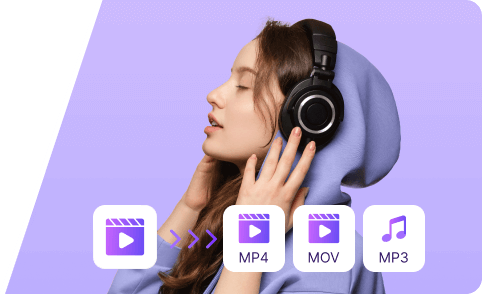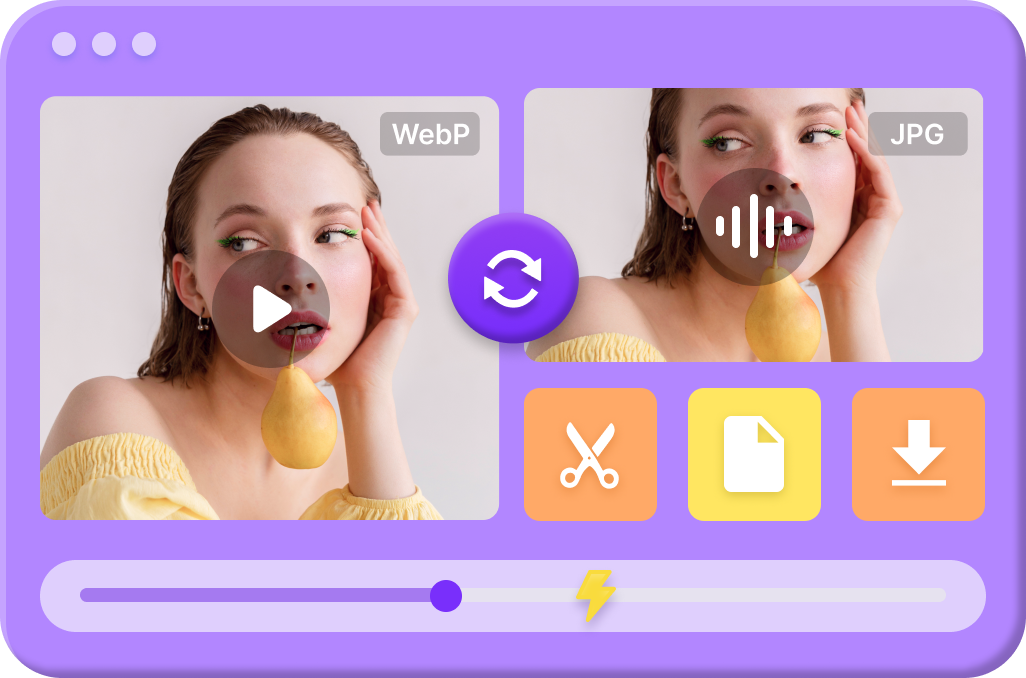WebP vs JPG:
Which Format is Right for You?
Among so many image options available, WebP and JPG are the two most popular image formats with different characteristics & usages. But which format is the best choice for you? Today, we'll detail WebP and JPG files, exploring their nature, pros & cons, converting ways, and helping you choose the right format that suits you.
Understanding WebP and JPG Formats
What is WebP File?
WebP is a relatively newer image format developed by Google. It was introduced with the goal of providing high-quality images with smaller file sizes, thus optimizing web page loading times. WebP uses both lossy and lossless compression techniques to achieve this, making it a versatile choice for different types of images.
- Website Performance Improvement
- High Compression Efficiency
- Transparency Support
- Animation Capabilities
Pros
- Limited Browser Support
- Slightly Quality Lose
- Limited Editing Capabilities
Cons
What is JPG Format?
JPG stands for Joint Photographic Experts Group and is one of the most common image formats worldwide. It is a widely recognized and accepted image format known for its compatibility with nearly all web browsers and devices .jpg files primarily use lossy JPG compression, which reduces image quality to some extent but often results in smaller file sizes.
- Wide Compatibility
- Full-Color Spectrum
- Suitable for Photographs
- Efficient Compression & Fast Loading
Pros
- Limited Support for Transparency
- Lossy Compression
- Unsuitable for Text and Line Art
Cons
Difference Between WebP and JPG
To help you make an informed choice, let's compare these two formats in a concise table:
| Feature | WebP | JPG |
| File Extension | .webp | .jpg |
| Developed by | IEC Joint Photographic Experts Group | |
| Compression Efficiency | Generally produces smaller file sizes | Larger file sizes, especially for photos |
| Image Quality | Comparable to JPG files, especially for web images | High-quality, ideal for photographs |
| Transparency | Supports true alpha channel transparency | Limited matte or "fake" transparency |
| Animation | Supports animated images | Static images, no animation |
| Browser Compatibility | Growing support, especially in modern browsers | Universally supported |
| Compression Settings | Adjustable compression settings | Adjustable compression settings |
Main Differences Between WebP and JPG
Now that we have a good understanding of WebP and JPG files individually, let's delve into the key differences between the two formats.
Compression Efficiency
WebP file takes the lead in terms of compression efficiency. It typically produces smaller file sizes while maintaining comparable image quality to .jpg files. This means faster loading times for web pages and less storage space needed for your image files.
Image Quality
JPG image is known for its ability to preserve high image quality, especially for photographs. However, WebP is catching up and often offers similar quality at smaller file sizes. The difference in quality might be unnoticeable but still significantly impacts web performance.
Browser Compatibility
JPG file is widely supported across all web browsers, making it a safe choice for compatibility. WebP, although gaining ground, might not be as universally supported, especially in older browsers. However, most modern browsers now offer support for WebP.
Transparency
If you require images with transparent backgrounds, a .webp file is the better choice. While JPG image supports a limited form of transparency (matte or "fake" transparency), WebP allows true alpha channel transparency, making it ideal for images like logos and icons.
Choosing the Right Format for Your Needs
The decision between WebP and JPG should be based on your specific needs. Here are some tips for you to choose a suitable format in different situations.
Choose WebP If:
- You need to optimize images for web performance.
- Transparency or animation is essential.
- You want to reduce loading times for your website.
- Browser compatibility with modern browsers is sufficient for your audience.
Choose JPG If:
- You're working with high-quality photographs.
- Universal browser compatibility is critical.
- You prioritize image fidelity over smaller file sizes.
- Transparency or animation is not a requirement.
Premium Converter
You're supposed to get a WebP to JPG converter free to change WebP images to JPG if you want a straightforward and widely accepted format to work on all platforms. Meanwhile, you may need to convert JPG to WebP format for web images with transparent backgrounds. Consider using our free online tools - WebP converter and JPG converter. These excellent converters allow you to convert images to WebP or JPG images super-fast & in high quality at no cost. If you want to convert images in batch without limits, try our Premium Converter, one of the best converters that are in a position to enhance your image quality, saving you time and effort. Besides, it supports 1,000+ formats to meet all your needs!
Premium Converter
4.8 1.5K ratings
Experience the highest quality conversion of video and audio across 300+ formats with our Premium Converter!

How to Convert WebP to MP4 or MP4 to WebP?
Here are four simple steps to convert video files with Pro Video Converter.
- Download Premium Converter on your device.
- Open the program. Then, go to the Image Converter tool and hit the + Add File key to import the file you want to change.
- Choose the desired format you want.
- Tap the Convert or Convert All button to convert the images.



Frequently Asked Questions (FAQs)
Is WebP of higher quality than JPG?
Both WebP and JPG can deliver excellent image quality. However, WebP's lossless compression option may provide a slight edge in preserving quality. Choose Premium Converter to change .webp and .jpg if you need, which can change JPG format to WebP or convert .webp to JPG in bulk without limits.
Are there any SEO benefits to using WebP images?
Yes, WebP's smaller file sizes and superior compression capabilities are in a position to improve website loading speed, which can positively impact SEO rankings.
Can I change WebP to JPG images?
Just try our Premium Converter, which allows you to convert WebP files to JPG in batch with no limits. Besides, not only can it convert files to JPG or WebP, but it also supports more than 1,000 format conversions and can enhance your image quality effortlessly.
Which format is better for web images: WebP or JPG?
It depends on your specific needs. WebP is excellent for optimizing image quality and loading times, while JPG image offers broader compatibility.
Can I use both WebP and JPG images on the same website?
Yes, it's a common practice to use WebP for modern browsers and JPG for older ones, ensuring a seamless experience for all visitors.
Conclusion
WebP vs JPG? Which is better? There is no absolute answer between WebP and JPG. Your choice between these image formats should be based on your specific project requirements. WebP file shines when it comes to web performance, transparency, and animations, while JPG image remains the go-to format for high-quality photographs and universal compatibility. Learning the differences and the strengths of WebP and JPG formats will help you make the right decisions to enhance your digital projects. Therefore, whether you're optimizing your website's loading speed or preserving your photo quality, choose wisely and let the image format work its magic.
Last updated: 2025-03-02

